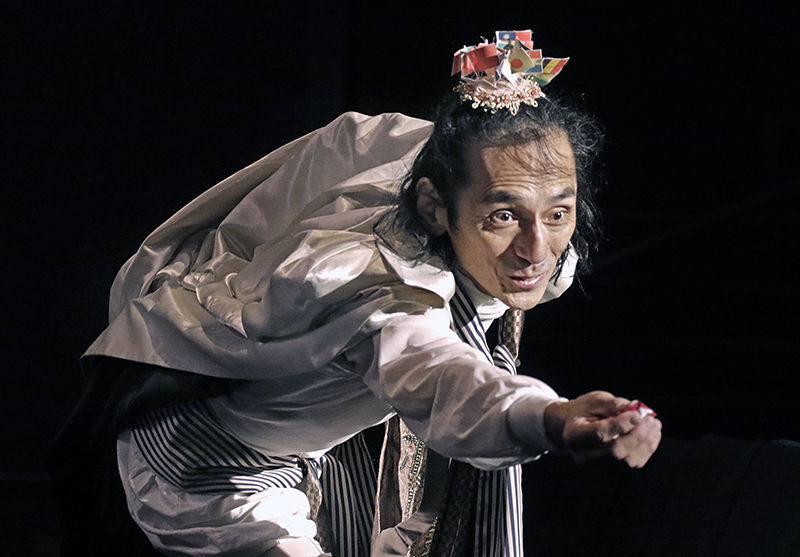Recently I caught a mesmerizing dance performance at the downtown REDCAT Theater: “Takao Kawaguchi: About Kazuo Ohno - Reliving the Butoh Diva’s Masterpieces.”
Ohno (1906-2010) was one of the founders of the revolutionary dance form known as Butoh, an avant-garde discipline, often done in white body makeup, that arose from the ashes of World War II.
As defined by Ohno himself: “Basically, ‘butoh’ means to meander, or to move, as it were, in twists and turns between the living and the dead.”
To watch a YouTube video of Ohno is to be transported to a world that is leagues apart from the aggressive, brute athleticism that characterizes so much of our contemporary skating, gymnastics, modern dance and even ballet.
“The best thing someone can say to me is that while watching my performance they began to cry,” he once said. “It is not important to understand what I am doing; perhaps it is better if they don’t understand, but just respond to the dance.”
Ohno converted to Christianity as a young man and remained a fervent Southern Baptist for the rest of his life. During WWII, he served in the Japanese Army and was held for three years as a POW. For much of his professional career, he worked by day as a physical education teacher at a private Christian school in Yokohama, retiring at the age of 86.
“Kazuo Ohno’s World: From Without and Within,” a collection of his essays, reflections and aphorisms, is a fascinating read.
“An authentic expression only emerges when body and soul reach crisis point. Look closely at plants. When in blossom, flowers are petal-laden right to the very tip of their limbs. But take a look at your fingertips: they’re lifeless. If your dance is to come to life in the same way a flower blossoms, then be flower-like. Look at trees! From the roots to the tip of their branches, they’re vibrantly expressive.”
When he was almost 70, he happened by chance upon a modern painting that jarred into consciousness the memory of having seen a performance, decades before, by the famed flamenco dancer Antonia Mercé (popularly known as “La Argentina”). “Admiring La Argentina,” which was developed in homage and first performed in 1977, became one of his most well-known pieces.
In “My Mother,” another of his signature dances, he wore a thigh-high romper with a ruffle down the back and carried a paper rose that functioned as an exquisitely sensitive antenna. Far from trying to hide his age, if anything, Ohno showcased it. Makeup clung to the crevices in his wrinkled face. His hands were gnarled, his back stooped, his arm skin crepey.
But there was nothing in his dance of willful repulsivity. “My intention in dressing as a woman onstage has never been to become a female impersonator, or to transform myself into a woman. Rather, I want to trace my life back to its most distant origins. More so than anything else, I long to return to where I’ve come from.”
The REDCAT performance was by Takao Kawaguchi, a Tokyo-based dancer who “reimagines” Ohno’s works in a way that is “itself an original.”
I arrived early with a friend to find the lobby awash in CalArts types and Kawaguchi himself, slithering silently about the floor in his underwear. I desperately wanted to use the ladies’ room, but was terrified of traversing the carpet lest he grab one of my legs and attempt to engage in a spontaneous interpretive dance.
But the performance itself was, as I said, mesmerizing. The stage was dark save for a clothes rack holding Kawaguchi’s costumes. Between dances, he changed slowly, teased his hair, gathered himself, applied makeup.
He opened with “The Fetus Dream” sequence from “My Mother,” reprised an episode from “Dead Sea” to a scratchy recording of what sounded like a sung Latin Mass, and performed “Dream of Love,” again from “My Mother,” to Franz Liszt’s “Liebestraum.”
The effect was extraordinary. Slight, elfin and sharp-featured, he variously evoked Charlie Chaplin, Maria Callas and the Virgin Mary, sorrowing at the foot of the Cross.
“I wanted to learn from [Ohno] the inside, the soul of the dance,” Kawaguchi has said. His movements tapped into the shadowy subconscious memory of our time in the womb and of that time on the other end — eternity — about which, for now, we can only wonder.
For much of the performance, Kawaguchi wore translucent white tights. From the first piece, one of his knees was bleeding.
That small detail — that tiny red stain amid so much white — for me emblemized Butoh. That this man who in his dedication to craft was so willing to take a back seat to the master, who was so willing to suffer for his audience before even reaching the main stage, was tremendously moving.
“Before employing techniques,” Ohno observed in his later years, “the question of mind, spirit or life must be considered.”
He was referring to dance, but could just as well have been speaking of writing or painting or prayer.
“The more techniques are applied, the more they push aside what is crucial. I don’t need techniques to lead my life after death.”
Heather King is a blogger, speaker and the author of several books.

